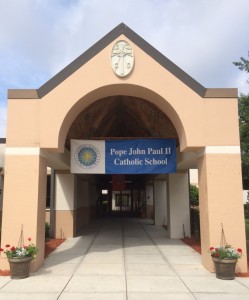The desks in Mary Ann Camisa’s classroom are arranged in the shape of a horseshoe, but one sits on its own, in the center.
 The middle spot is reserved for the fourth-grader who is designated the “Christian citizen” – a rotating designation for the student who had come to class the most prepared, or displayed the best attitude.
The middle spot is reserved for the fourth-grader who is designated the “Christian citizen” – a rotating designation for the student who had come to class the most prepared, or displayed the best attitude.
The seat of honor is a reminder that Pope John Paul II Catholic School in Lecanto, about 80 miles north of Tampa on Florida’s Gulf Coast, is different than the other schools in the area, both public and private. It also helps explain why parents in this exurban stretch of Florida are on edge.
Pope John Paul II is the only Catholic school in Citrus County. And like other Catholic schools around the country, its future is in doubt.
Closure would mean long hauls to Ocala or Spring Hill for those who want to keep their kids in Catholic schools. It would also mean the loss of a community anchor – the same kind of loss, frankly, that public school parents often feel when their neighborhood schools are shuttered or at risk of folding.
“What we have here is intangible,” Camisa, a 22-year veteran of the school, said as her students wrapped up a school day late last month. “It’s the environment. It’s something gets instilled along the way.”
Parents learned in early March that the Diocese of St. Petersburg, faced with flagging enrollment and the need for costly repairs, was on the verge of closing the 29-year-old school. It serves about 150 students from preschool to eighth grade.
Since then, the parents have held rallies and enrollment drives. They’ve started raising money for repairs. They’ve tried to spread the word about scholarships and subsidies that can help families afford a Catholic education.
Bishop Robert Lynch told school supporters the school had been on “life support,” and declining enrollment had made the diocese’s financial support more difficult. But he also indicated he would be willing to hear a plan to boost enrollment and make the school more sustainable.
On Friday, the parents were putting finishing touches on a plan to increase enrollment in coming years. They’re expecting to find out in a matter of weeks, if not sooner, what the diocese thinks of it – and whether their school can stay open for another year.
For all kinds of reasons, Catholic schools nationwide have seen declining enrollment for decades. This, despite being widely recognized for solid academics and character education and a special willingness to serve low-income families.
“The availability of a Catholic education is one of the important factors some families look at before they move to a new place,” the Citrus County Chronicle wrote in a recent editorial. “A quality, results-oriented religious education is part of the fabric of any community.”
Kim Colitz would agree. The mother of a first-grader and a pre-schooler at John Paul II said she appreciates that the curriculum is designed to instill a sense of right and wrong. “They learn here at an early age to make the right choices and that you are accountable for your actions,” she said.
To some extent, the potential closure of Pope John Paul II cuts against the grain of the story line in Florida. For the past two years, Catholic school enrollment increased in Florida, fueled by a trio of state-backed school choice programs.
That includes the tax-credit scholarship program for low-income families, which is administered by Step Up for Students, which co-hosts this blog. There are also private Catholic groups that offer assistance.
The parents at John Paul II want to replicate the growth that is happening elsewhere.
Debbie Desautel, chair of the school’s advisory council, said they’ve signed up nearly 20 new students in recent weeks and and hope to attract more. They’re also hoping a relatively new voluntary prekindergarten program will help attract more families who will stay for the long haul.
“Once you know us,” she said, “you’re going to love us.”


